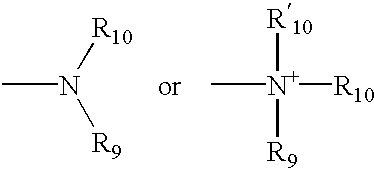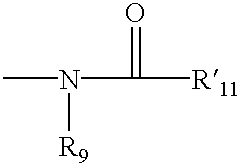Ligands for monoamine receptors and transporters, and methods of use thereof
a monoamine receptor and transporter technology, applied in drug compositions, cardiovascular disorders, metabolic disorders, etc., can solve the problems of limited number of compounds that can be synthesized, limited choice of reagents and conditions that can be used for the synthesis of non-oligomeric libraries, and desensitization of the receptor or ion channel
- Summary
- Abstract
- Description
- Claims
- Application Information
AI Technical Summary
Problems solved by technology
Method used
Image
Examples
example 2
Synthesis of [1-(4-chloro-phenyl)-cyclobutyl]-(3-hydroxymethyl piperidin-1yl)-methanol
[0373] 16
[0374] A solution of amide 1 (300 mg, 0.977 mmoles) dissolved in anhydrous toluene (10 mL) was cooled to 0.degree. C. RedA1 (691 mg, 3.4 mmoles) was added dropwise to the cooled stirring reaction mixture. After completion of addition the reaction continued stirring at RT. After 12 h, 10% KOH was added to the reaction mixture. The aqueous layer was extracted with EtOAc (3.times.5 mL). The combined organic layers were dried over Na.sub.2SO.sub.4 and concentrated to yield an oil. The crude material was purified using silica gel chromatography (4:1 hexanes:EtOAc-4:1 EtOAc:hexanes) to yield 2 (230 mg, 0.785 mmole, 80%). .sup.1H (CDCl.sub.3) .delta.7.32-7.12 (4H, m), 3.66-3.47 (2H, m), 2.80-1.28 (17H, m). LRMS: M+293.
example 3
Synthesis of [1-(4-chloro-phenyl)-cyclobutyl]-(3-phenoxymethyl piperidin-1yl)-methadone
[0375] 17
[0376] A solution of 1 (2.07 g, 6.72 mmoles), triphenylphosphine (2.64 g, 10.08 mmole), and phenol (1.27 g, 13.44 mmoles) dissolved in anhydrous ether (50 mL) was cooled in a brine bath to -5.degree. C. DEAD (1.60 mL, 10.08 mmoles) dissolved in ether (10 mL) was added to the cooled stirring reaction mixture. After completion of addition, the reaction mixture continued stirring at -5.degree. C. After 4 h, the reaction mixture was concentrated and crude material was dissolved in a hexane / ethyl acetate mixture (70% hexanes:30% ethyl acetate, 30 mL). Phosphine by-products precipitated and were filtered off. The filtrate was concentrated to yield an oil. This oil was purified using silica gel chromatography (100% hexanes-1:1 hexanes: EtOAc) to yield the amine 3 (840 mg, 2.19 mmole, 32%). LRMS: M+384.
example 4
Synthesis of [1-(4-chloro-phenyl)-cyclobutyl]-3-phenoxymethyl-piperidine
[0377] 18
[0378] A solution of amide 3 (0.5 g, 1.3 mmole) dissolved in anhydrous toluene (15 mL) was cooled to 0.degree. C. RedA1 (920 mg, 4.55 mmole) was added dropwise to the cooled stirring reaction mixture. After completion of addition, the reaction continued stirring at RT. After 12 h, 10% KOH was added to the reaction mixture. The aqueous layer was extracted with EtOAc (3.times.20 mL). The combined organic layers were dried over Na.sub.2SO.sub.4 and concentrated to yield an oil. The crude material was purified using silica gel chromatography (100% hexanes-9:1 hexanes:EtOAc) to yield 4 (300 mg, 0.811 mmoles, 62%). Enantiomers 5 and 6 were isolated on a chiral AD column (100% MeOH). .sup.1H (CDCl.sub.3) .delta.7.35-6.86 (9H, m), 3.80-3.64 (2H, m), 2.65-1.15 (15H, m). .sup.13C (CDCl.sub.3) .delta.159.3, 148.6, 131.0, 129.7, 128.0, 127.8, 120.7, 114.7, 70.7, 69.0, 59.2, 56.6, 47.3, 36.4, 31.9, 31.8, 27.0, 45.0,...
PUM
| Property | Measurement | Unit |
|---|---|---|
| temperature | aaaaa | aaaaa |
| temperature | aaaaa | aaaaa |
| temperature | aaaaa | aaaaa |
Abstract
Description
Claims
Application Information
 Login to View More
Login to View More - R&D
- Intellectual Property
- Life Sciences
- Materials
- Tech Scout
- Unparalleled Data Quality
- Higher Quality Content
- 60% Fewer Hallucinations
Browse by: Latest US Patents, China's latest patents, Technical Efficacy Thesaurus, Application Domain, Technology Topic, Popular Technical Reports.
© 2025 PatSnap. All rights reserved.Legal|Privacy policy|Modern Slavery Act Transparency Statement|Sitemap|About US| Contact US: help@patsnap.com



